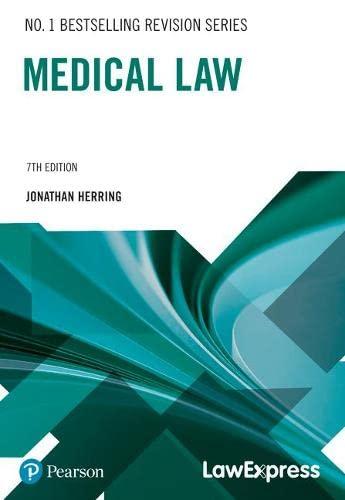Question
In Brown v.Board of Education (1954), the Supreme Court ruled that racial segregation in public schools violated the Equal Protection Clause of the Fourteenth Amendment
InBrown v.Board ofEducation (1954), the Supreme Court ruled that racial segregation in public schools violated the Equal Protection Clause of the Fourteenth Amendment because "separate isinherentlyunequal." If separate is inherently unequal, this of course means that legally required racial segregation violates the Equal Protection Clause. However, does this mean, in addition to not legally requiring the segregation of students based on race, that schools should be legally required to have "racially balanced" student populations? In other words, should the racial composition of the school be required to match the racial composition of the surrounding area's population (i.e., if the county is 60% white, 30% Hispanic, and 10% black, should each school in the county be required to approximate those percentages in its student population?)? Why or why not?
1. The question of whether schools should be legally required to have racially balanced student populations is complex and contentious. While ensuring racial diversity in schools has benefits in promoting understanding and tolerance among different racial groups, mandating strict racial quotas raises concerns about fairness and potential unintended consequences. Such policies may overlook other factors influencing school demographics, such as housing patterns and socioeconomic disparities. Additionally, enforcing strict racial balancing could lead to challenges in implementation and may not address underlying issues of systemic inequality. Therefore, while promoting diversity and inclusivity in schools is important, alternative approaches that address the root causes of segregation and promote equal access to quality education for all students may be more effective in achieving meaningful integration.
2. compare and contrast the Above response with the information you have learned from Ginsberg, Benjamin. We the People (Essentials Edition). Available from: Yuzu Reader, (14th Edition). W. W. Norton, 2022. Explain what the Above response did well and what it did not do well, focusing on accuracy, depth, and relevance to the prompt. This compare-and-contrast section MUST CONTAIN *SPECIFIC, PROPERLY CITED* REFERENCES TO THE TEXTBOOK AND COURSE MATERIALS TO RECEIVE CREDIT! Merely citing the textbook as a whole, or a textbook chapter or chapters, or a course item like a PowerPoint file, will not be sufficient to receive credit. You must cite the specific page, or slide number, or subsection title that you are referencing. Once finished, submit your post to the discussion board.
Step by Step Solution
There are 3 Steps involved in it
Step: 1

Get Instant Access to Expert-Tailored Solutions
See step-by-step solutions with expert insights and AI powered tools for academic success
Step: 2

Step: 3

Ace Your Homework with AI
Get the answers you need in no time with our AI-driven, step-by-step assistance
Get Started


